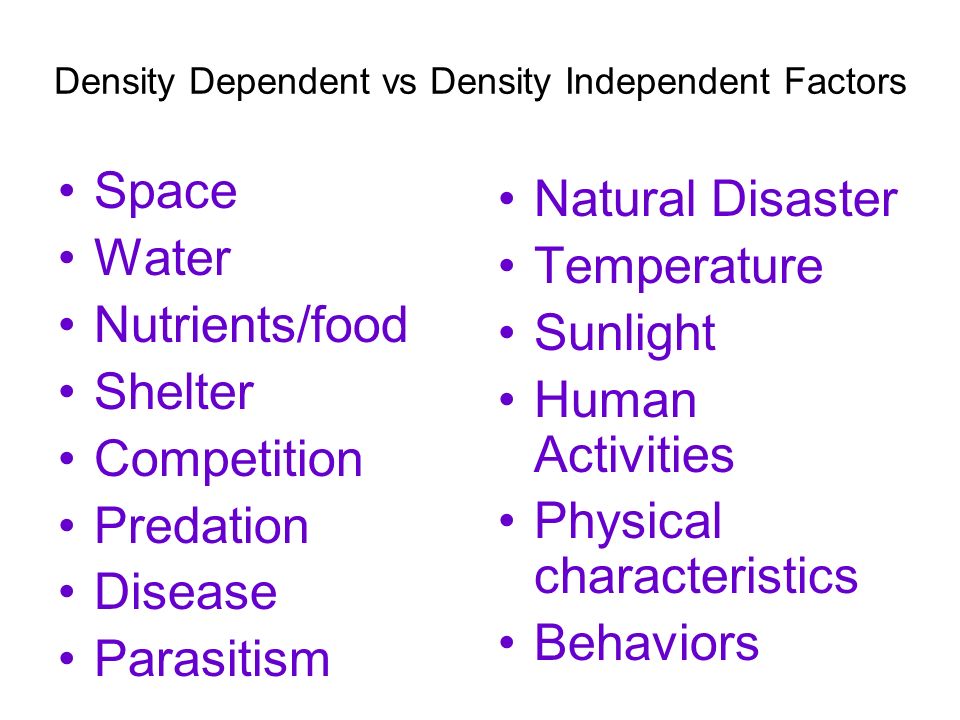

The waste produced by the fish, along with the fish which die from starvation, are too much for the filter to handle and the tank will soon become a stinky mess. Further, as the fish are so crowded, it doesn’t matter how much the owner feeds them, some fish simply do not get fed.

This reduces the energy and vigor each fish has, reducing their chances of surviving and reproducing. The amount of oxygen in the water will be depleted, as the filter and aerator cannot keep up with the number of gills in the tank. In this case, each fish will barely have any space. Now consider a tank with an extremely high density of fish, and you can see how these density dependent factors now negatively affect the population growth. Because there is plenty of room and food, the fish can all get some. Their waste can easily be filtered out by the filter, and the owner of the tank can easily distribute food to all the fish. Likewise, the fish require little food as a collective group, and produce little waste. The filter and aerator add oxygen to the water as fast as the fish can consume it, so there is plenty. In a tank with a low density of fish, each fish has its own space, and has plenty of oxygen. These factors are density dependent because they will become drastically more limiting as more fish are added to the fish tank. Fish need food, oxygen, and a way to detoxify water of their own wastes. In a fish tank, the factors are slightly different. There are certain density dependent factors which will limit and affect the population size of the organisms in the tank.
Density independent factors Patch#
Likewise, a fish tank is no different than a patch of grass. At this point, the growth and reproduction of all plants in the population is slowed, and the population gets close to the point of equilibrium, all other things remaining equal. As the plants start to crowd in on each other, each plant will have limited access to these valuable resources. If a plant has sole access to a large area, it will receive more nutrients, water and sunlight. For a plant, all of these resources are tied to the area a plant has access to. Consider the resources a plant needs: sunlight, moisture and nutrients. While nothing changed in the factors themselves, the population became to dense and the resources became source. Over time, the spaces between the plants filled in, until the field represented a high population density.Īt this point, various density dependent factors in the environment switched from positively affecting the plants to negatively affecting them. For several generations, they had all the space and nutrients they needed to grow as fast as they could. They seeded the field carefully, placing seeds far apart to simulate a low population density. What they found was a perfect example of density dependent factors affecting the growth rates of an organism.Īt first, the scientists had and empty field, freshly tilled with no plants in it. While the saying “watch the grass grow” is often used as a euphemism for boredom, scientists have actually done just that. Examples of Density Dependent Factors Watching Grass Grow There are usually many density dependent factors involved for a given population. The various factors which cause this leveling off in the population are density dependent factors. But, as the density dependent factors change their effects on the population, the growth slows and the population size tends to level off. Logistic curveĪs the graph shows, the population increases rapidly for a time. This tends to make populations experiencing density dependent factors to show logistic growth, like in the graph below. When the population is large and dense, these factors become limited and decrease the birth rate while raising the death rate. When the population is small, these factors typically favor increased birth rates and lower death rates, allowing the population to expand. Density dependent factors cause variable changes in the population as its density changes. These can be things like food, shelter, or other limited resources. Typically, density dependent factors are biological factors used by the population as a resource. Like density independent factors, density dependent factors are unique for every population, and density dependent factors for one species or population may not be the same for all populations. Unlike density independent factors, which are not tied to the population density, density dependent factors change how they affect the population as the population changes in size.

Density dependent factors affect a population through increasing or decreasing birth and death rates, in a way that is directly related to the density of the population.


 0 kommentar(er)
0 kommentar(er)
